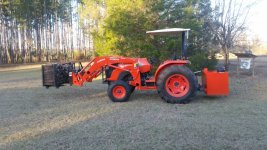rbtjr
Gold Member
We have a L3800 with which we use a Titan ballast box. We have this ballast box up to about 750# including its weight, sand and 5 suitcase weights we put on top of the sand. We have a MX5800 on order. The MX will have a LA1065 FEL. The heaviest attachment we will have on the FEL is a 4n1 bucket at 640#. The rear tires will be loaded, which will add about 1050#. We can get the Titan box up to about 900# with some scrap iron and concrete. Or, we could consider something like the Kubota ballast box that when filled would weigh 1500#. I have read some posts that indicate that significant ballast is frequently needed for the MX tractors. I know that the ballast needed depends on what you are doing with the tractor, but do you MX owners have any advice about whether a 900# box would usually work well or if we would usually need more like the 1500# box? Thanks in advance for your advice.

